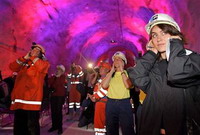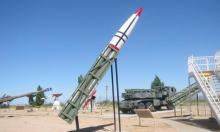Switzerland opens world's longest tunnel under Alps
Swiss officials Friday inaugurated the world's longest overland tunnel, a 34.6-kilometer-long (21-mile-long) rail link under the Alps meant to ease highway traffic jams in the mountainous country.

The tunnel, which took eight years to build and cost 4.3 billion Swiss francs (US$3.5 billion; 2.6 billion EUR), will trim the time trains need to cross between Germany and Italy from 3½ hours to just under two.
The first train through the tunnel was a freight carrying Swiss Transport Minister Moritz Leuenberger, arriving in the town of Frutigen at the tunnel's north entrance. It burst through a banner declaring "Loetschberg - Connecting Europe" to the cheers of more than 1,000 people and the popping of fireworks.
"We have moved a mountain," Leuenberger said.
A Roman Catholic bishop and a Protestant minister blessed the tracks, and several bands played. At one point, the festivities moved along so briskly that officials had to slow them down for the punctually arriving train.
After the inaugural journey, a second train carried journalists and other passengers southward - a smooth and quiet ride on rubber-cushioned rails that are suitable for high-speed trains from Germany, France and Italy. Freight trains will be able to travel at speeds up to 160 kph (100 mph) and passenger trains at up to 250 mph (150 mph).
Midway through the tunnel, the train stopped so officials could show off the emergency and maintenance area, and they served white wine, Swiss cheese and dried beef called buendnerfleisch. Cellphone reception was strong throughout the ride, even at points where the tunnel was 2,000 meters (6,500 feet) below the mountain surface.
When it arrived on the other side, travelers were greeted by the Valaisian Alps - some still snowcapped - and hundreds of children waving Swiss flags and cheering "Bravo" in the city of Visp.
Loetschberg is the longest land tunnel, surpassing Japan's 26.5 kilometer (16.4 mile) Hakkoda Tunnel. But it is shorter than the 53.9-kilometer (33.5-mile) undersea Seikan Tunnel, also in Japan, and the 50.4-kilometer (31.3-mile) Channel Tunnel connecting France and England.
The Loetschberg was dug parallel to an even more ambitious project - the 57-kilometer (36-mile) Gotthard Tunnel, which will be the world's longest when it is completed in 2017.
The Loetschberg tunnel will get skiers to Swiss resorts more quickly. The trip from Bern, at the northern end of the tunnel, to Visp, near ski regions like Switzerland's Zermatt and Italy's Courmayeur on the southern side of the Alps, will be cut in half - from 110 minutes to 55 minutes.
By running at low elevation, the tunnel will be able to accommodate trains and cargo loads that cannot negotiate the long climb and switchbacks to existing tunnels higher up the mountain.
As villagers in Frutigen watched the inaugural ceremony, the steady stream of freight and passenger trains on the old track on the hill above the tunnel underscored the importance the connection would serve to traffic between Italy and Germany.
For Swiss taxpayers - who are paying for the twin, multibillion-dollar ( -euro) construction projects - the main selling-point was that it would move heavy trucks off their crowded highways and onto trains.
Switzerland is at the center of a north-south European axis where traffic has increased more than tenfold since 1980. The Swiss have tired of traffic jams caused by big rigs and vacationers filling their narrow valleys, and the rail plan has remained popular despite running billions of dollars (euros) over budget.
"We did not want to become part of the road corridor for 40-ton trucks streaming north and south, and so decided to opt for rail tunnels," Leuenberger said.
Passenger trains will start traveling through the tunnel on Dec. 9. From then on, 72 freight trains and 43 passenger trains will pass through the tunnel every day.
The Loetschberg was designed to be a twin tunnel, with traffic moving in both directions through separate tubes. Due to cost constraints, however, only one side has been completed. It remains unclear if the second, parallel tube would be finished as well. In the meantime, trains will alternate traveling in opposite directions through the finished part.
Subscribe to Pravda.Ru Telegram channel, Facebook, RSS!





